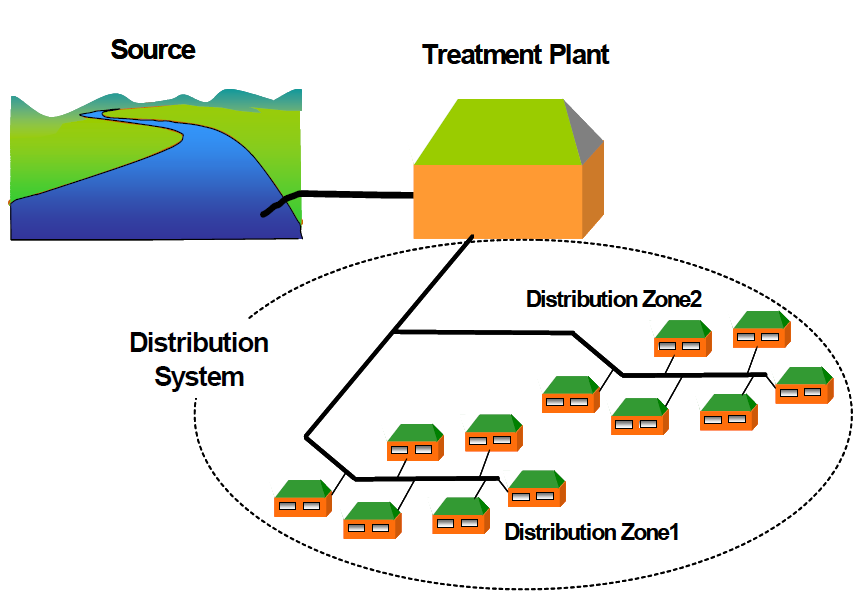About drinking water quality and health
This section provides information about drinking water quality, how it affects our health, and water fluoridation.
On this page:
Why is safe drinking water important to health?
Safe drinking water is vital for human health. Water that is contaminated with pathogens may cause diseases, particularly gastrointestinal diseases. These water borne diseases can cause diarrhoea and vomiting.
Drinking water supplies can be treated to remove pathogens and make the water safe to drink.
Untreated or insufficiently treated drinking water supplies often contain E. coli. This bacteria indicates the presence of faecal matter, and an increased likelihood of waterborne pathogens (disease-causing organisms).
Waterborne pathogens can include:
- bacteria
- protozoa (single-celled organisms).
Since 1996, the number of people in New Zealand on registered supplies that comply with the bacterial and protozoal requirements has steadily increased [1].
Waterborne diseases related to drinking water
Waterborne diseases can be caused by contact with contaminated water. The Environmental Health Indicator project monitors the incidence of the three notifiable waterborne diseases:
Campylobacteriosis is caused by a bacterium, usually Campylobacter jejuni or C. coli [2]. Symptoms include abdominal pain, fever and diarrhoea, often with bloody stools.
Cryptosporidiosis is caused by the intestinal parasite Cryptosporidium [3]. The main symptoms are diarrhoea and cramps.
Giardiasis is caused by the protozoan parasite Giardia intestinalis. The main symptoms are diarrhoea and cramps.
Anyone can be affected by these diseases, but young children, older adults and people with weakened immune systems are more vulnerable.
These diseases can all be contracted in a variety of ways, not just by drinking untreated water. Other risk factors for contracting these diseases include contact with recreational water, farm animals, sick animals, faecal matter, other symptomatic people, and consuming contaminated food [4].
Read the latest statistics on waterborne diseases on the waterborne diseases related to drinking water webpage.
Drinking water supplies in New Zealand
The majority of New Zealanders are supplied with water by a reticulated supply (piped water distribution) (Figure 1). Treatment plants are used to remove actual or potential contaminants and ensure the water delivered is safe to drink [5].
In isolated areas, water supplies may simply consist of a pipe from a well, river or lake, perhaps with a pump and storage tank.
Figure 1: The components of the water supply system, including a distribution system with two distribution zones 
Source: ESR [6]
For more information on drinking water supplies in New Zealand, visit the Drinking Water for New Zealand website.
Monitoring of drinking water supplies
Drinking water supplies in New Zealand are tested for microbiological and chemical compliance with the Drinking water Standards for New Zealand. These standards set maximum acceptable levels to protect human health.
Microbiological compliance of drinking water supplies is based on two main microbiological reference organisms, E. coli and Cryptosporidium.
- Bacteriological compliance is determined primarily using E. coli monitoring.
- Protozoal compliance is based on monitoring the effectiveness of the treatment processes used to remove or disinfect Cryptosporidium.
Chemical compliance is also assessed for certain drinking water supplies [7].
The Ministry of Health and ESR publish annual reports on drinking water quality in New Zealand. These reports are based on surveys of drinking water suppliers. The surveys collect information about microbiological and chemical quality of the drinking water, and water treatment processes.
Read the latest statistics about the population with access to safe drinking water on the access to safe drinking water webpage.
Adding fluoride to drinking water helps prevent tooth decay
Fluoride can be added to water as a public health measure to prevent tooth decay. Water fluoridation can benefit everyone, but gives the greatest benefits to children and those most at risk of tooth decay.
Fluoride in drinking water helps to reduce tooth decay, by strengthening and rebuilding tooth enamel. It can also slow down and repair early signs of tooth decay.
With the exception of thermal areas, New Zealand has a naturally very low water fluoride concentration.
The Ministry of Health recommends a water fluoride concentration of 0.7–1.0 parts per million, in line with World Health Organization (WHO) guidelines. Evidence shows that the added fluoride poses no health risk at this level, and does not change the nature or purity of drinking-water [8].
It is the responsibility of local authorities to decide whether to implement community water fluoridation.
Read the latest statistics on the access to fluoridated drinking water webpage.
Oral health of children
Living in an area with fluoridated drinking-water can help prevent tooth decay (caries). In particular, children’s oral health can benefit from access to fluoridated water.
Studies have shown that children with poorer oral health in New Zealand include those who are on a non-fluoridated water supply [9-12], of Māori ethnicity [13], of low socio-economic status [11,12], and live in a rural area [14].
In New Zealand, community oral health services collect oral health data for 5-year-old children and children in school-year 8 (about 12–13 years old). This oral health data can be compared for areas with and without fluoridated water.
Measures used in measuring the oral health of children:
- percentage of children who are caries free
- the lifetime experience of dental decay – measured as the number of decayed, missing or filled teeth, in primary teeth (dmft) or permanent teeth (DMFT).
Read the latest statistics on the oral health of children webpage.

